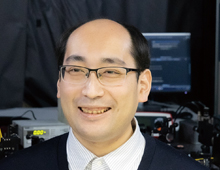Low-Dimensional Quantum Device Research Unit
Principal Investigator
- PI Name
- Yuya Shimazaki
- Title
- Unit Leader
- Brief Resume
2016 Ph. D., The University of Tokyo 2016 Postdoctoral Researcher, The University of Tokyo 2017 Postdoctoral Researcher, Quantum Photonics Group, ETH Zurich, Switzerland 2021 Research Scientist, Quantum Electron Device Research Team, RIKEN Center for Emergent Matter Science 2024 Project Associate Professor, Quantum-Phase Electronics Center, School of Engineering, The University of Tokyo (-present) 2024 Unit Leader, Low-Dimensional Quantum Device Research Unit, Cross-Divisional Materials Research Program, RIKEN CEMS (-present)

Outline
Our unit focuses on the exploration of physics in novel quantum devices utilizing low-dimensional structures formed by the moiré interference effects of crystal lattices and semiconductor microfabrication, primarily based on two-dimensional materials. In particular, we aim to elucidate the quantum many-body physics and quantum device physics in semiconductor moiré superlattices through electrical control and probing and control through optical excitation. Starting from bulk single crystals of layered compounds, our research comprehensively covers the fabrication of heterostructures of two-dimensional materials, device fabrication, electrical control, optical measurements, and electrical transport measurements at extremely low temperatures, as well as the development of necessary equipment and software.
Research Fields
Physics, Engineering, Materials Sciences
Keywords
Two-dimensional materials (2D materials)
Nanodevices
Spectroscopy
Strongly correlated system
Condensed matter physics
Results
Electrical control and excitonic sensing of semiconductor moiré lattices
Two-dimensional materials, which are atomically thin materials, can acquire new functionalities by being stacked together. When two-dimensional material crystals with similar lattice constants are overlaid, moiré interference can create periodic nanostructures with a period of about 10 nanometers, longer than the original crystal’s periodicity. By utilizing transition metal dichalcogenides, which are semiconductor two-dimensional materials, it is possible to electrically control and optically detect electrons in these moiré lattices. By fabricating high-quality heterostructures, we have successfully realized insulating states arising from strong electron correlations in such electrically controlled semiconductor moiré lattices. Specifically, using excitonic transitions as sensors, we have succeeded in optically detecting unique interlayer charge transfer behaviors and the formation of charge order. Additionally, we have established various control methods, such as the electrical control and optical detection of tunnel coupled states of holes in the moiré lattice, the electrical control of hybrid states of excitons, and the Feshbach resonance through electrical manipulation. Such highly controllable semiconductor moiré lattices hold great potential for use as simulators of quantum condensed matter physics.

(a) A superlattice created by moire interference of two-dimensional material crystals (moire lattice) (b) Strongly correlated electrons in a semiconductor moire superlattice and sensing by excitons (c) Electrical control of hybrid states of excitons (d) Feshbach resonance of excitons and holes induced by electrical control
Members
Yuya Shimazaki |
Unit Leader | yuya.shimazaki[at]riken.jp |
|---|
Publications
- A. Popert, Y. Shimazaki, M. Kroner, K. Watanabe, T. Taniguchi, A. Imamoglu, and T. Smolenski
Nano Lett. 22, 7363–7369 (2022)Optical Sensing of Fractional Quantum Hall Effect in Graphene
- I. Schwartz, Y. Shimazaki, C. Kuhlenkamp, K. Watanabe, T. Taniguchi, M. Kroner, and A. Imamoglu
Science 374, 336 (2021)Electrically tunable Feshbach resonances in twisted bilayer semiconductors
- T. Smoleński, P. E. Dolgirev, C. Kuhlenkamp, A. Popert, Y. Shimazaki, P. Back, X. Lu, M. Kroner, K. Watanabe, T. Taniguchi, I. Esterlis, E. Demler and A. Imamoğlu
Nature 595, 53 (2021)Signatures of Wigner crystal of electrons in a monolayer semiconductor
- Y. Shimazaki, C. Kuhlenkamp, I. Schwartz, T. Smolenski, K. Watanabe, T. Taniguchi, M. Kroner, R. Schmidt, M. Knap, and A. Imamoglu
Phys. Rev. X 11, 021027 (2021)Optical Signatures of Periodic Charge Distribution in a Mott-like Correlated Insulator State
- Y. Shimazaki, I. Schwartz, K. Watanabe, T. Taniguchi, M. Kroner and A. Imamoglu
Nature 580, 472 (2020)Strongly correlated electrons and hybrid excitons in a moiré heterostructure
- Y. Shimazaki, M. Yamamoto, I. V. Borzenets, K. Watanabe, T. Taniguchi, and S. Tarucha
Nat. Phys. 11, 1032 (2015)Generation and detection of pure valley current by electrically induced Berry curvature in bilayer graphene
Contact Us
2-1 Hirosawa, Wako 351-0198 Japan
E-mail:
yuya.shimazaki[at]riken.jp
